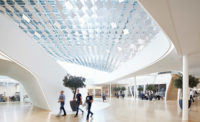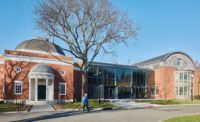More dynamic interaction among colleagues is what lighting manufacturer Osram had in mind for its new 130,000-square- foot headquarters inside a 1980s-era speculative office building in Wilmington, Massachusetts. For the first time, researchers, business units, sales, administration, and customer operations are occupying the same location. When the company tapped Sasaki and HLB Lighting Design to ready the leased space, its brief paired companywide collaboration with “the challenge to build with light,” says Boston-based Sasaki principal Victor Vizgaitis. “You were to know who Osram was and what it did from the moment you walked into the building.” The project largely employs products from Osram’s Sylvania Lighting Solutions group.
Sasaki aimed to foster awareness of the brand and its multiple departments with an illuminated double-height entry sequence, which comprises a lobby and adjacent two-story pre-function area and includes a gracious central stairway. Here the ceiling is called a “super-ray,” in which 9-by-9-inch tiles of programmable LEDs are mounted behind acrylic panels. “This is a person’s first impression of what Osram can do,” Vizgaitis says, and, accordingly, the super-ray is as dynamic as it is immersive. The entire surface measures 2,637 square feet, bathing visitors in bright light or treating them to a show of colors or video sequences. Select Osram facility managers program the super-ray by smartphone app. The architects then placed labs, meeting rooms, and other enclosed spaces at the core of the office, making them visible from the entrance. That move also kept the perimeter open for more general office spaces, maximizing occupant exposure to daylight and views in a floor plate that exceeds 200 feet on each side.
On the upper floors, the perimeter space is divided into neighborhoods by more modest “rays” of light: spaces for wayfinding and collaboration that are wedge-shaped in plan, where knife-edge LED-embedded pendants uplight dropped white ceilings at a 3000K color temperature. “The rays needed to be bright and airy, without making the adjacent workspaces appear dim,” HLB senior associate Robyn Goldstein says of tuning the light to produce an even wash that cues wayfinding and social interaction. In the adjacent office zones, exposed ceilings and a color palette of grays create distinction from the more social spaces located beneath the rays, and rows of bidirectional LED pendants mounted 12 feet on center provide a mix of direct and indirect 3000K illumination.
Vizgaitis does not compare Osram’s rays and super-ray to a cathedral dome or Yale’s coffers, but he does think that landmarked ceilings offer a lesson to the humbler makers of commercial workspaces. “Ceilings are in our direct line of sight, but they’re often overlooked,” he says. “Designers have to treat them with as much importance as any of the four walls.”
CreditsArchitect: Sasaki
Personnel in architect's firm who should receive special credit: PIC, Victor Vizgaitis, AIA Engineers Structural, McNamara/Salvia, Inc. Consultants Lighting, HLB Lighting
General contractor: Commodore Builders
Photographer: ©Anton Grassl/ESTO Anton Grassl 5 Sycamore Street Cambridge, MA
|
SpecificationsInterior Finishes Acoustical ceilings: USG Translucent, Armstrong Ultima Cabinetwork and custom woodwork: The Woodworks Architectural Millwork Inc. Paints and stains: Sherwin Williams Wall coverings: Carnegie Floor and wall tile: Lobby and stair, Rein Ceramiche
Furnishings Office furniture: Teknion Reception furniture: Bernhardt
Lighting Interior ambient lighting: Traxon, Osram, FLOS, Axis Dimming system or other lighting controls: Encelium |









Post a comment to this article
Report Abusive Comment